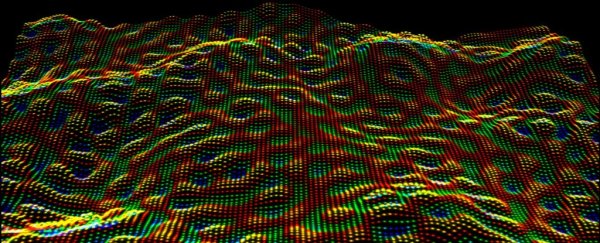Classical and quantum physics are defined by what makes them so different, but an even bigger question has plagued physicists for decades: what links these two opposing views together? Why do the fundamental laws of classical physics fail at the quantum level, and can they be reconciled?
Now, thanks to a newly developed material, scientists might be closing in on the answer, because they've devised a way to see quantum mechanics occur on a scale visible to the naked eye.
"We found a particular material that is straddling these two regimes," says team leader N. Peter Armitage, from Johns Hopkins University.
"Usually we think of quantum mechanics as a theory of small things, but in this system quantum mechanics is appearing on macroscopic length scales. The experiments are made possible by unique instrumentation developed in my laboratory."
The material in question is a type of topological insulator. This type of material was first predicted back in the 1980s, and scientists have been producing different variations of it since 2007.
Topological insulators are special because they're conductive on their outer layer but, internally, it's an insulator. This means that electrons can only flow along the outside of the material, causing them to display some really weird behaviours.
For their experiment, Armitage and his team created topological insulators made from pieces of bismuth and selenium that were about the size of finger nail clippings of various thicknesses.
They revealed for the first time that these two elements offer a way for physicts to see the quantum phenomena on a much larger scale than usual.
To figure this out, they sent a beam of terahertz radiation (sometimes called THz or T-rays – an invisible spectrum of light) through these insulators, measuring the beam as it travelled.
The team found that the beam changed as it passed through the material by rotating slightly – an effect that's usually only observed at the atomic scale.
Even better, the amount of change they saw could be accurately predicted using the same complex mathematics that govern at the quantum level. This is the first time researchers have witnessed quantum mechanics occurring on the macro scale in a topological insulator.
That might not sound like a big deal, but the insulator has given the team a rare opportunity to reproduce a quantum effect in a larger object, and it shows a promising link between the world of quantum and classical mechanics.
This link is something scientists have been chasing for decades, as part of the hunt for the elusive 'theory of everything'.
To put it simply, scientists know that the rules of the quantum world - which explain how atoms operate on an extremely small scale - have to somehow be linked to the everyday classical world - the rules of bigger systems, like how a ball rolls or a rocket is launched.
But the problem is, this link is elusive. Many of the rules of classical physics break down at the quantum level. For example, gravity, which is crucial to our world, doesn't seem to affect quantum systems at all, and the rules of classical physics can't explain the 'spooky action at a distance' of quantum entanglement.
This experiment suggests that topological insulators could be the way we finally see that link once and for all, if we can continue to manipulate them further.
Though the new experiment is definitely a step in the right direction and "a piece of the puzzle", according to Armitage, there's still a lot of work for researchers to do before the link between the two different physical worlds is fully understood.
The hope is that one day we'll have a completed picture of physics, and new materials like the team's topological insulator might be the way we get there.
The team's work has been published in Science.
